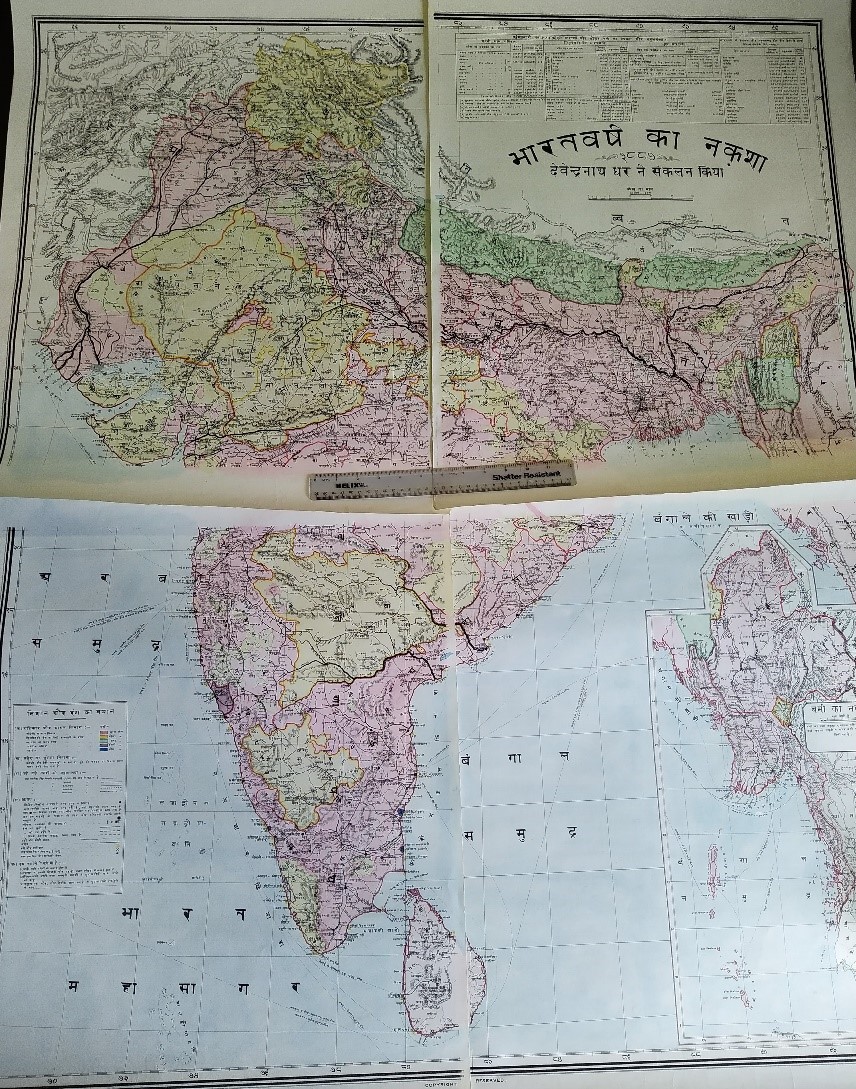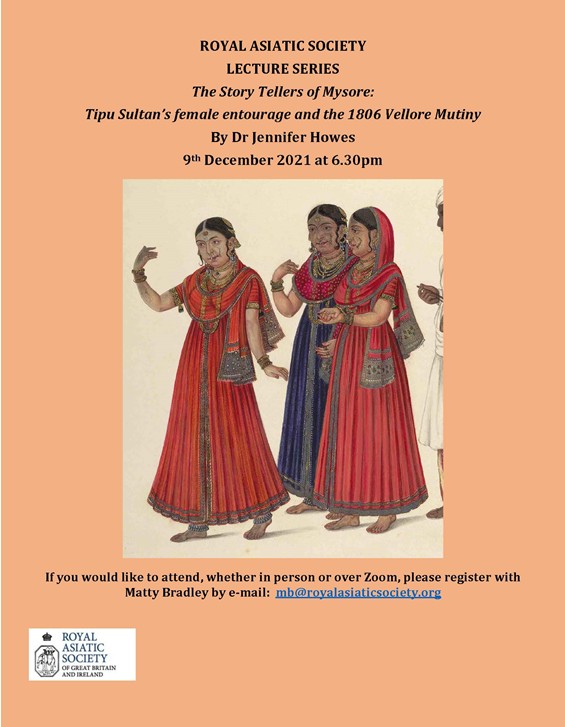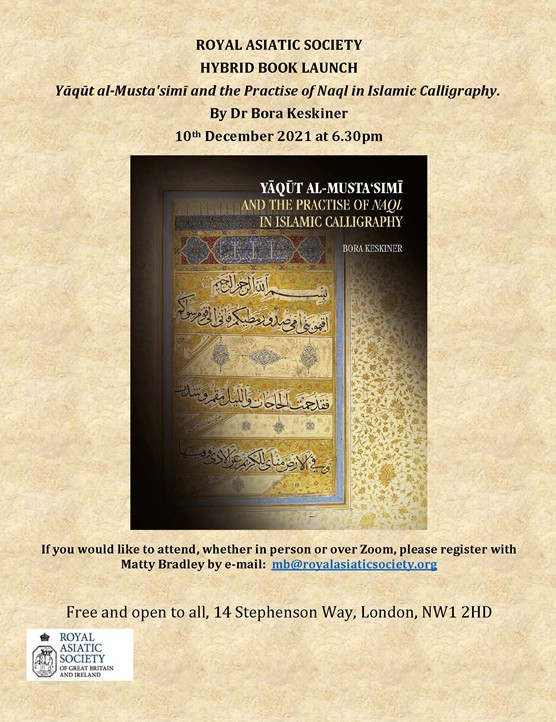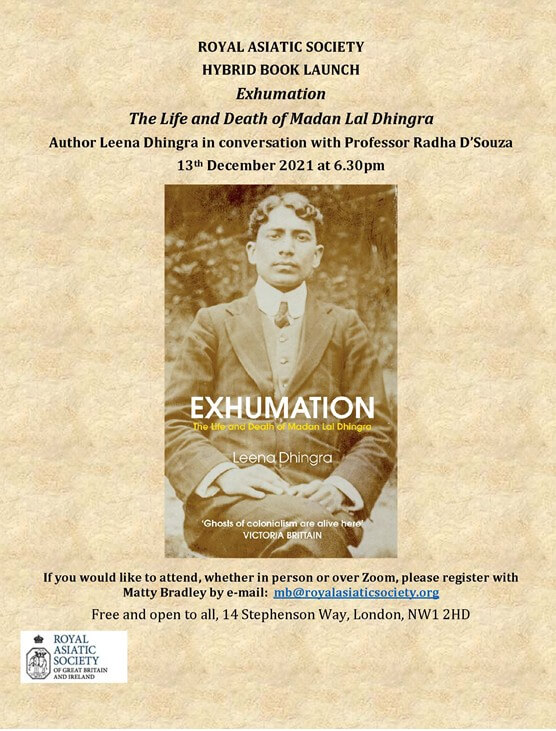The self-taught cartographer and his Hindi wall map of India
In his final blog for the year, Philip Jagessar writes about a Hindi wall map of India which was sent to the Society by a Calcutta-based mapmaker.
The Royal Asiatic Society’s reputation for reviewing the latest works of “science, literature and the arts in relation to Asia” appears to have extended to maps, encouraging some enterprising mapmakers to post their work to the Society for appraisal, publicity, and perhaps even financial support. Some of these maps were sent from abroad and, unsurprisingly, many came from mapmakers based in Asia.
In 1889, a Calcutta-based mapmaker named Devendranath Dhar sent the Society a copy of his colourful Hindi wall map of India (in four sheets) which he had produced as a cheaper option for local schools in India, having spotted a gap in the market. According to the letter accompanying the map, Dhar asked for “any kind suggestion or friendly criticism for the improvement of my map” from members of the Society and hoped that the map might be recommended to other interested or knowledgeable parties for review. It was not uncommon for maps, like books, to be circulated for such reasons. Dhar even attached a leaflet with numerous (positive, of course) “opinions” of his map from leading newspapers in India and members of the colonial government.

The second and possibly most important reason why Dhar sent this map to the RAS was to gather support for “efforts…to publish in future better and more descriptive maps in one or other of the four vernacular languages named below: I) Bengali II) Hindi III) Urdu IV) Oriya.” Vernacular education in India gradually expanded in the latter half of the 19th century and Dhar clearly saw an opportunity to create cheap maps in several languages for schools across the province of Bengal and further afield.

What makes this map particularly compelling is Devendranath Dhar’s cartographic expertise: he was essentially an autodidact, a self-taught mapmaker. This attractive Hindi wall map was his first attempt at compiling, lithographing and publishing a map. Dhar explains in his letter to the RAS that he had great difficulty “compiling the map direct on stone” (central to the lithography process) because of “almost no previous experience of such work”. The whole process took Dhar just under two years to finish and the only help he received was at the final stage of printing which he undertook at a “lithographic establishment under European supervision”.
For a first attempt with little to no experience, Dhar’s Hindi wall map is an impressive piece of work. He evidently had an aptitude for mapmaking and managed to achieve one of his principal goals: producing a cheaper map. Purchasing the map coloured and mounted would only cost 5 rupees. Dhar also stressed the aesthetic quality of the map, suggesting to the Society that they should mount the four sheets on cloth and apply varnish on its surface otherwise it “loses much of its beauty.” Dhar would have sent one already mounted but the imperial postal service would not allow him to send such a large parcel overseas.

Unfortunately, the RAS did not heed his instructions as the map remains unmounted and in four sheets today. And, as far as we can tell, Dhar never received the support he perhaps sought but did receive a letter of thanks and appreciation for his map. Although the RAS did at times support cartographic projects and publish maps, the plan to produce maps in other vernacular languages would have been one of many private mapmaking projects proposed which the RAS would not – or could not – support for various reasons. Instead, Dhar’s map survives as a reminder that the Royal Asiatic Society was seen as central to the advancement of science and art – including cartography – in, and of, Asia.
Philip Jagessar
Upcoming events:
As previously mentioned in last week’s blog, we have a number of events taking place before the Christmas break.
Dr Jennifer Howes:
Please join us at 6:30pm on Thursday December 9th for a hybrid lecture given by Dr Jennifer Howes on ‘The Story Tellers of Mysore: Tipu Sultan’s female entourage and the 1806 Vellore Mutiny’.
After the Fourth Mysore War, when the British were dismantling Tipu Sultan’s establishment, the East India Company unexpectedly took charge of 601 women who resided permanently in Srirangapatnam Palace. Along with Tipu’s sons, they were moved 200 miles east to Vellore Fort, in the Company-controlled territory of Madras Presidency. Documentation about these court women held in colonial archives describes moments when they behaved in unexpectedly difficult ways. Dr Howes argues that rather than being seen as voiceless victims, these sources show that the women were using the domestic powers granted to them under Tipu Sultan’s establishment to influence their treatment by the East India Company.
Dr Jennifer Howes is a London based Art Historian specialising in the art and architecture of India. In 1999 she was awarded a PhD in Art and Archaeology from the School of Oriental and African Studies and then worked for 14 years as the Curator of Visual Arts at the British Library.

Dr Bora Keskiner:
On the 10th December at 6:30pm we also have the hybrid book launch of Dr Bora Keskiner’s publication, ‘Yāqūt al-Musta’simī and the Practise of Naql in Islamic Calligraphy’.

Leena Dhingra
For one of the final events of the year, we will be welcoming Leena Dhingra on Monday December 13th at 6:30pm for the launch of her publication, ‘Exhumation: The Life and Death of Madan Lal Dhingra’. More information about the book is available here: https://www.hoperoadpublishing.com/fiction/exhumation
Leena Dhingra was born in India, and came to Europe after the 1947 Partition of India. She published her first novel Amritvela in 1988. She is also an actor, having starred in The Bill, Casualty, Prime Suspect and Dr Who. She will also be joined in conversation with the critical scholar and social justice activist, Radha D’Souza.

To register for any of these events, please email mb@royalasiaticsociety.org, stating your preference for attending virtually or in-person. We look forward to seeing many of you there!
